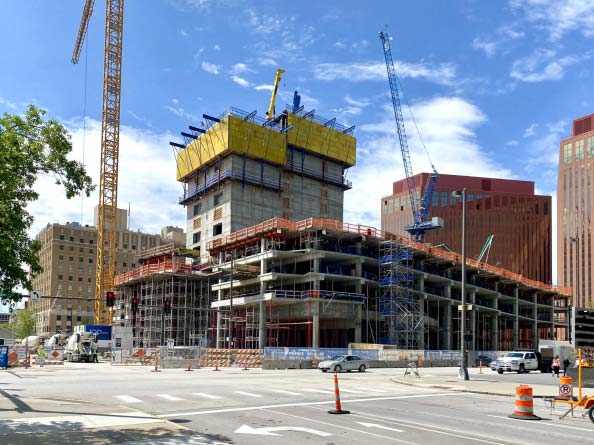
Visual construction progress is underway on Mutual of Omaha’s future headquarters – which will rise to 677 feet and 44 floors tall – as the building’s shear core, akin to a “spine,” takes shape.
Construction of a skyscraper of this magnitude within a small footprint in a populated downtown area can present challenges. With the ingenuity of something called the DOKA Shear Core Climber, or self-climber, the project is making safe and efficient strides.
“Mutual of Omaha currently has the second largest self-climber ever built in the U.S.,” said Brian Krouse, Director of Construction with Lanoha Real Estate Company, the developer for the project. “Not only does the formwork provide a mold for forming the shear core, it also creates a safe working environment, serving as a hive of activity with crews working at three levels within the core.”
Over the next several months, the construction crew will engage in a repetitive cycle of preparing, pouring and erecting the shear core. The self-climber, which is identifiable as a yellow encasement around the structure, creates a mobile concrete formwork system surrounding three levels of the structure at a time.
The entire self-climbing formwork structure weighs approximately 1 million pounds. The top deck, which is above the yellow encasement, receives materials while iron workers tie rebar for the walls. The middle level, inside the yellow encasement, is a work platform for installation of rebar for the shear walls, as well as steel embeds and block-outs to be installed in the walls before they are poured. The lowest level of the system is a working platform and gantry system for the installation of steel beams, metal deck and concrete that form the floors within the core.
After the concrete is poured and sufficiently cured, 18 hydraulic cylinders lift the top two levels of the self-climber 15 feet to its new position. Once they are locked into place, the hydraulics lift the bottom level up to create the new platform position. The work cycle will repeat to a full height of 650 feet near the top of the tower. When the core work is complete, the tower crane will be used to disassemble the self-climber and safely lower its components to the ground.
“The assembly of the self-climber itself has been a culmination of months of engineering, planning and pre-assembly of the many parts that create the mobile concrete formwork system,” Krouse said. “A representative from DOKA, which is based in Germany, will be on site every week to make sure all the components to this intricate system are working properly.”


